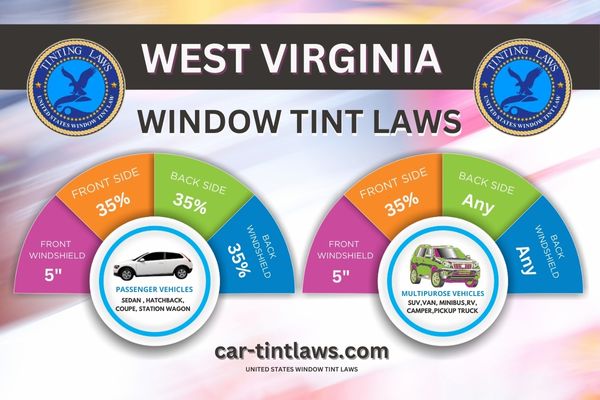When contemplating window tinting for your vehicle in West Virginia, you have particular regulations to adhere to in order to avoid fines.
Did you realize that sedans require a minimum of 35% tint darkness on the front and back side windows, as well as the rear window?
Additionally, the tint’s reflectivity must be under 20% for front side windows. Reflective and non-reflective tints each have their own regulations, and comprehending these is crucial to remain in compliance.
Intrigued about the consequences and exceptions? There’s more to delve into regarding how these laws impact you.
Window Tint Darkness in West Virginia
When it comes to window tint darkness in West Virginia, the rules vary based on the type of vehicle you drive.
For sedans, front side windows must allow more than 35% of light transmission, while SUVs and vans have no restrictions on the tint darkness for rear and side windows.
Understanding these differences is essential for ensuring your vehicle complies with state regulations.
Tint darkness for sedans:
- Windshield: Non-reflective tint is allowed on the top 5 inches of the windshield.
- Front Side windows: Must have a minimum of 35% tint darkness.
- Back Side windows: Must have a minimum of 35% tint darkness.
- Rear Window: Must have a minimum of 35% tint darkness.
Tint darkness for SUV and Vans:
- Windshield: Tinting is allowed on the top 5 inches of the windshield.
- Front Side windows: Must allow more than 35% of light in.
- Back Side windows: Any shade can be used.
- Rear window: Any shade can be used.
Window Tint Reflection in West Virginia
When it comes to window tint reflection in West Virginia, you need to know that the state mandates reflectivity levels must be less than 20% for both front and back side windows.
This requirement applies to all vehicles, including sedans, SUVs, and vans, ensuring that metallic elements in the tinting film don’t cause excessive glare.
Adhering to these regulations is essential for maintaining visibility and safety on the road.
Tint reflection for sedans:
- Front Side windows: Ensure the tint reflection is less than 20%.
- Back Side windows: Verify that the tint film used does not exceed the state’s permitted reflectivity level.
- Certification and Identification: Proper certification and identification of tinting materials are essential for legal compliance.
- Reputable Services: Work with reputable window tinting services familiar with West Virginia’s regulations.
- Documentation: Ensure the service provider gives you documentation proving compliance with state requirements.
- Metallic Elements: Be cautious as metallic elements in tinting film can contribute to overall tint reflection.
Tint reflection for SUV and vans:
- Front Side windows: Reflectivity must not exceed 20%.
- Back Side windows: Reflectivity must not exceed 20%.
- Tinting Film: Metallic elements can be used to achieve desired reflectivity while complying with the law.
- Prohibited Colors: Avoid red, amber, and yellow tints on SUVs and vans.
- Back Window Tint: Dual mirrors are required for vehicles with tinted back windows for adequate visibility.
- Compliance: Adhering to these guidelines ensures legal limits and vehicle safety in West Virginia.
Other West Virginia window tint rules and regulations
- Side Mirrors: No restrictions.
- Restricted Colors: In West Virginia, all tint colors are permitted.
- Certificates: Manufacturers of film need to certify the film they sell in the state. Ensure that your dealer is using certified film.
- Stickers: The sticker/label of compliance to identify legal tinting is required between the film & glass on each tinted window.
- Medical Exceptions: West Virginia allows for medical exemptions for special tint. To learn more about the specific terms of the exemption, refer to WV state law.
- Penalties: Violating window tint laws in West Virginia can result in fines. It’s crucial to adhere to these regulations to avoid potential costs.

Medical Exemptions for Window Tint Rules in West Virginia
Many West Virginians with medical conditions can obtain darker window tints by acquiring a medical exemption.
If you have a specific medical condition that necessitates additional protection from sunlight, West Virginia’s window tint laws allow for exceptions.
To qualify for a medical exemption, you’ll need an affidavit from a certified physician or optometrist that outlines the medical necessity for darker tint.
This process guarantees that individuals with medical needs can comply with window tint regulations while addressing their health requirements.
The affidavit must provide detailed information about your medical condition and why darker window tint is crucial.
Conditions such as lupus, melanoma, or other sunlight-sensitive ailments are typically covered. Once the affidavit is submitted and approved, you’ll be permitted to use a darker tint than normally allowed by state regulations.
These medical exemptions are crucial for ensuring that those with specific medical conditions can safely drive without the harmful effects of sunlight.
By following the proper steps and securing the necessary documentation, you can benefit from this provision and maintain your health and safety on the road.
Remember, it’s vital to keep the approved documentation in your vehicle to avoid potential issues with law enforcement.
West Virginia Window Tint Ticket Cost
Understanding the medical exemptions is just one part of staying compliant with West Virginia’s window tint laws; knowing the cost of a window tint ticket and other regulations is equally significant.
In West Virginia, if you’re caught violating window tint regulations, you could face fines ranging from $100 to $200.
These costs aren’t just a slap on the wrist; they aim to guarantee road safety and maintain visibility standards.
Violations don’t just hit your wallet; you might also be required to remove the illegal tint.
This can add an extra layer of inconvenience and cost. To avoid these penalties, it’s essential to understand the specific Visible Light Transmission (VLT) percentages allowed for different windows in your vehicle.
Front side windows, back side windows, and rear windows all have distinct VLT percentages that must be adhered to.
Complying with these regulations not only helps you avoid fines but also contributes to overall road safety.
Being part of a community that follows the rules makes the roads safer for everyone. So, make sure you’re well-informed about the West Virginia window tint ticket cost and adhere to the specified VLT percentages to stay penalty-free.
West Virginia Population Statistics
When considering West Virginia’s window tinting laws, it’s also important to understand the state’s population trends.
West Virginia has a population of approximately 1.79 million people, with a density of around 73 people per square mile.
The population distribution, including urban versus rural demographics, as well as age and gender statistics, plays a significant role in shaping state regulations and policies.
Population Growth Trends
West Virginia’s population dynamics reveal a stable yet subtly declining trend, particularly marked by an aging demographic and rural depopulation.
In recent years, the state’s population has experienced a slight decrease, influenced by several key factors.
One of the most notable is the aging population, with a higher percentage of older residents compared to the national average.
This demographic shift plays a significant role in the overall population decline, as younger individuals often leave the state in search of better job opportunities and more vibrant economic conditions.
The economic conditions in West Virginia have also had a considerable impact on population trends.
The state has faced challenges in creating and maintaining job opportunities, which has led many to seek employment elsewhere.
Migration patterns show that more people are leaving the state than moving in, contributing to the subtle but steady decline in population.
While the overall population remains relatively stable, these combined factors highlight the importance of addressing economic and employment issues to foster a sense of belonging and community growth.
Understanding these trends can help residents and policymakers alike in shaping a more prosperous future for West Virginia.
Urban Vs. Rural Demographics
In West Virginia, about 1.8 million people are spread across both urban hubs like Charleston and Huntington, and the expansive rural areas that dominate the state’s landscape.
This mix of urban and rural demographics influences various aspects of life, including West Virginia’s window tinting laws.
Urban areas, with their higher population densities, tend to have more stringent regulations due to increased vehicle traffic and the need for safety and law enforcement efficiency.
In contrast, rural demographics, which make up a significant portion of the state’s population, often face different challenges and requirements.
Rural residents might have more lenient window tinting laws due to fewer vehicles on the road and less strict law enforcement presence.
The difference in population distribution means that urban residents might have easier access to services and resources, while rural residents often need to travel longer distances for similar amenities.
Understanding these urban vs. rural demographics is vital when considering how window tinting laws are applied and enforced across West Virginia.
By recognizing the unique needs and characteristics of both urban and rural communities, better regulations can be crafted to guarantee safety and compliance throughout the state.
Age and Gender Distribution
The population statistics of West Virginia reveal a balanced gender distribution and an older median age compared to the national average.
With approximately 1.79 million residents, West Virginia maintains a fairly even split between males and females.
Women make up about 50.5% of the population, while men account for 49.5%. This balanced gender distribution is a significant aspect of the state’s demographic profile.
In terms of age distribution, West Virginia has a median age of around 42 years old, which is slightly higher than the national average.
This older median age reflects the presence of a significant older population within the state. Specifically, individuals aged 65 and over constitute about 20% of the total population.
The higher proportion of older residents plays an essential role in shaping West Virginia’s social dynamics and community needs.
Understanding the age and gender distribution can be important when considering various aspects of life in West Virginia, including window tinting laws.
These demographic factors can influence legislative priorities and the specific needs of different population segments, ensuring that laws are tailored to serve the community effectively.
References
West Virginia Code, Article 17C, Chapter 15, Section 17C-15-36a: Sun-screening devices; penalty
Frequently Asked Questions
What Is the Darkest Legal Tint in Wv?
When you’re considering tint darkness in WV, the darkest legal tint is 35% VLT for front and rear side windows on cars.
While it offers privacy and safety, enforcement can be strict. Proper installation and maintenance are essential.
What Are the Tint Laws in West Virginia 2024?
In 2024, you’ll need to know West Virginia’s tint percentage requirements: 35% VLT for front windows on passenger cars.
Enforcement procedures are strict. There are exemptions for medical conditions and recent changes in tint laws to take into account.
Is There a Tint Waiver in West Virginia?
Yes, you can get a tint waiver in West Virginia. Just provide a medical exemption affidavit from your doctor.
During vehicle inspections, make sure your tint percentage complies with your exemption to avoid issues. You’re part of a considerate community!
How Much Is a Tint Ticket in Wv?
So, you thought you’d outsmart the law with dark windows? A tint ticket in WV costs $100 to $200.
Enforcement procedures might even require tint removal. Fines impact your wallet, and illegal tints can hamper visibility.
Conclusion
Understanding West Virginia’s window tinting laws is essential for compliance and avoiding fines.
Remember, sedans must have a minimum 35% tint darkness on all side and rear windows.
Reflectivity is limited to less than 20% on front side windows. One interesting statistic: over 1.8 million people live in West Virginia, making it vital to follow these rules for safety and visibility.
Always make sure your tint materials are certified and display compliance stickers.
